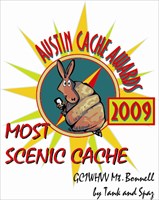Mt. Bonnell, summiting at 775 ft above sea level is said to be the highest point in Austin – and the incredible views certainly support that theory. However, parts of the Jollyville Plateau top out at 1100 feet. Still, it's a heady view, and a favorite tourist destination since the mid 1800s, Situated in Austin’s Covert Park, some lovely stone steps will give you a workout to the summit – but the views are worth it!
THE GEOLOGY:
A mere 300 million years ago (give or take), this was the seashore. Eons of erosion and deposition built up, causing a shear right along here at the Balcones (for “balcony”) Escarpment in the Tertiary period – about 65 million years ago. Basically everything to the east ‘slumped,’ but here at the seam rocks were faulted and crumpled. Water, such as the Colorado River below, did its work over the centuries along the various fault and fracture lines, leaving the steep valleys you see around you. The Balcones Escarpment has long gone quiet – the last earthquake activity was during the Miocene, about 15 million years ago, probably due to additional subsidence of the coastal plain under the weight of all the river and gulf sedimentary deposits.
Mt. Bonnell sits on the Balcones Fault Zone “divide.” Upstream is the higher (uplifted) section of the Balcones and the Hill Country – the Edwards Plateau; downstream extends out into the Blackland Prairie – essentially flat all the way to the Gulf. The rock under your feet was deposited as limy muds and oozes with some occasional sands on the shallow sea bottom during a period roughly 180 to 80 million years ago. [1]
Mt. Bonnell itself is comprised of Glen Rose limestones from the lower Cretaceous period (late Upper Aptian into the Lower Albian), meaning these rocks are about 115-105 million years old. Glen Rose topography (famous for dinosaur tracks, though you won’t find any up here to my knowledge) tends to be terraced, alternating hard and soft layers of limestone. “The east slope of the summit of Mount Bonnell …is a familiar example of the terraced Glen Rose slopes, the different benches succeeding one another like the treads of an ordinary stairway.”[2] While we are familiar with water shaping our landscape, here you can also see the effects of wind, which blows away the powdery material of the softer Glen Rose layers, undermining the hard, rocky layers until they become projecting; shelves, which then collapse under their own weight. The bluffs of Mount Bonnell are largely of this nature. Interestingly, “the very steep and in places impassable bluffs of the western side of Mount Bonnell have been formed from the same beds which on the other side of the mountain weather into terraced slopes. It is necessary only to follow the terraced beds of the eastern face of this mountain around to the west side to observe the change from the bench and terrace to the bluff character.” [3]
Note that the bedding here is essentially horizontal. To the east, on the ‘graben’ (or dropped) side of the Balcones Fault Zone, you’ll find tilted bedding and more fracturing, until it’s completely covered by the deep soils of the prairie.
You can also expect to find some marine fossils in the area – though Mt Bonnell itself is pretty picked over. Most commonly found are varieties of oysters (and the most common of those are the Texigraphea oysters, well over 100 million years old), as well as a fair number of bivalves (clams), depending on where you’re looking. Kinda fun to beach comb in the heart of Texas!
THE NAME:
There are two candidates for the Mt Bonnell moniker. Most popular is the attribution to Texas newspaperman George W. Bonnell, who published “The Texas Sentinel” and was prominent in early Texas and Travis County (Austin) affairs after the War for Independence. Equally probable, however, is that Albert Sidney Johnston may have named Mount Bonnell for his friend and fellow West Point graduate Joseph Bonnell, a Captain and Aide de Camp to General Houston in the Texas War for Independence, and a recognized hero of the Texas Revolution. Unfortunately there is no ‘smoking gun’ documentation for either namesake.
More “romantically,” local legend claims Mount Bonnell was once called Antoinette's Leap, after a young woman who leaped to her death to escape the Native American raiding party that killed her fiancé.
Covert Park is so named not because lovers sneak up there for a tryst, but, rather to honor Frank M. Covert Sr., who donated the land.
Stay for the sunset – it is spectacular from here. But, mind, the park is closed from 10pm-6am.
TO LOG THIS CACHE:
1. To gain credit for this cache ascend to the summit.
2. Look East at the topography and describe what you see.
3. Look West at the topography and describe what you see.
4. Now compare the two, describing how they differ, and how they got this way.
5. Optional: Please post a picture of yourself/team at the site with your GPS.
Answers with "I dont know; Cant find it; etc..," or failing to answer the first four questions will cause your log to be deleted.
Each person who logs a find must submit their own answers, no group emails.
Please be mindful to remain on all paved and hard surfaces.
Do not go off-roading or damage the natural habitat in any way.
This is a learning opportunity, that many will want to join in on, so CITO and leave no trace when visiting.
I do not reply to correct answers. So please log your find once you have completed the cache and submitted your answers. If there are any concerns, I will contact you.
ALL LOGS THAT DO NOT HAVE ANSWERS SUBMITTED WITH 72 HOURS WILL BE DELETED.
REFERENCES & FOOTNOTES:[1] Roadside Geology of Texas; Robert A. Sheldon; Mountain Press Publishing Co; 2nd printing 1982
[2] Glen Rose Formation from “Geography and geology of the Black and Grand prairies, Texas, with detailed descriptions of the Cretaceous formations and special reference to artesian waters Publication 4171875“ http://www.lib.utexas.edu/books/landscapes/publications/txu-oclc-4171875/txu-oclc-4171875-a-144.html
[3] Ibid Mt Bonnell, Wikipedia article http://en.wikipedia.org/wiki/Mount_Bonnell
Austin Explorer “Mount Bonnell” http://www.austinexplorer.com/Locations/ShowLocation.aspx?LocationID=1791
Guidebook to the Geology of Travis County Field Trip No.2 : Balcones Fault Zone http://www.lib.utexas.edu/geo/ggtc/ft2.html
Guidebook to the Geology of Travis County Chapter 5 : Collecting Localities for Fossils in Austin http://www.lib.utexas.edu/geo/ggtc/ch5.html
Austin Park Profiles :Mount Bonnell http://www.articlesbase.com/nature-articles/austin-park-profiles-mount-bonnell-550815.html
Texas State Historical Association Balcones Escarpment http://www.tshaonline.org/handbook/online/articles/rxb01 Quick
Fossil Identification link at Bulk Fossils By PaleoScene www.paleo.cc http://paleo.cc/fossils/bulkfossils.htm



